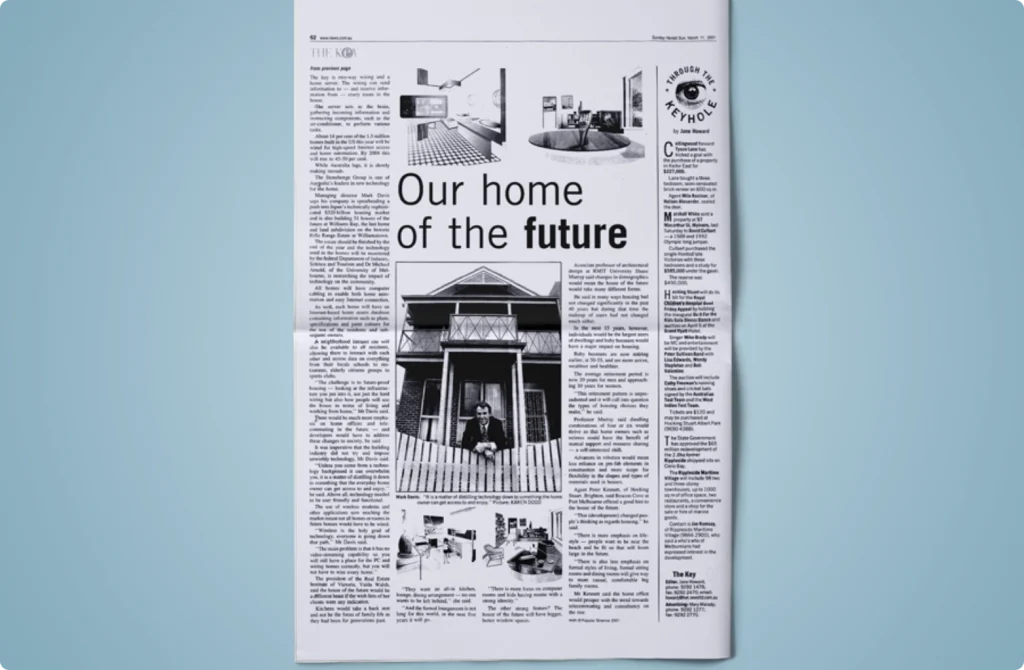

The key is two-way wiring and a home server. The wiring can send information to – and receive information from – every room in the house.
The server acts as the brain, gathering incoming information and instructing components, such as the air-conditioner, to perform various tasks.
About 14 per cent of the 1.5 million homes built in the US this year will be wired for high-speed internet access and home automation. By 2004 this will rise to 45-50 per cent.
While Australia lags, it is slowly making inroads.
The Stonehenge Group is one of Australia’s leaders in new technology for the home.
Managing director Mark Davis says his company is spearheading a push into Japan’s technically sophisticated $320 billion housing market and is also building 51 houses of the future at Williams Bay, the last home and land subdivision on the historic Rifle Range Estate at Williamstown.
The estate should be finished by the end of the year and the technology used in the homes will be monitored by the federal Department of industry, Science and Tourism Dr Michael Arnold, of the University of Melbourne, is researching the impact of technology on the community.
All homes will have computer cabling to enable both home automation and easy internet connection.
As well, each home will have an internet-based home asset database containing information such as plans, specifications and paint colours for the use of the residents and subsequent owners.
A neighbourhood intranet site will also be available to all residents, allowing them to interact with each other and access data on everything from their locals schools to restaurants, elderly citizens groups to sports clubs.
“The challenge is to future-proof housing – looking at the infrastructure you put into it, not just the hard wiring but also how people will use the house in terms of living and working from home.” Mr Davis said.
There would be much more emphasis on home offices and telecommunicating in the future – and developers would have to address these changes to society, he said.
It was imperative that building industry did not try and impose unwieldy technology, Mr Davis said.
“Unless you come form a technology background it can overwhelm you, it is a matter of distilling it down to something that the everyday home owner can get access to and enjoy.” He said. Above all, technology needed to be user friendly and functional.
The use of wireless modems and other applications now reaching the market meant not all home or rooms in the future houses would have to be wired.
“Wireless is the holy grail of Technology, everyone is going down that path,” Mr Davis said.
“The main problem is that it has no video-streaming capability so you still have a place for the PC and wiring homes correctly, but you will not have to wire every home.”
The president of the Real Estate Institute of Victoria, Valda Walsh, said the house of the future would be a different beast if the wish lists of her clients were any indication.
Kitchens would take the back seat and not be the focus of family life as they had been for generations past.
“They want and all-in kitchen, lounge, dining arrangement – no one wants to be left behind”, she said.
“And the formal lounge room is not long for this world, in the next five years it will go.”
“There is more focus on computer rooms and kids having rooms with a strong identity.”
The other strong feature? The house of the future will have bigger, better window spaces.
Associate professor of architectural design at RMIT University Shane Murray said changes in the demographics would mean the house of the future would take many different forms.
He said in many ways housing had not changed significantly in the past 40 years but during that time the makeup of users had not changed much either.
In the next 15 years, however, individuals would be the largest users of dwellings and baby boomers would have a major impact on housing.
Baby bookers are now retiring earlier, at 50-55, and are more active, wealthier and healthier.
The average retirement period is now 20 year for men and approaching 30 years for women.
“This retirement pattern is unprecedented and to will call into question the types of housing choices they make,” he said.
Professor Murray said dwelling combinations of four or six would thrive so that home owners such as retirees could have the benefit of mutual support and resource sharing – a self-interested shift.
Advances in robotics would mean less reliance on pre-fab elements in construction and more scope for flexibility in the shapes and types of materials used in houses.
Agent Peter Kennett, of Hocking Stuart, Brighton, said Beacon Cove at Port Melbourne offered a good hint to the house of the future.
“That (development) changed people’s thinking as regards housing,” he said.
“There is more emphasise on lifestyle – people want to be near the beach and be for so that will loom large in the future.
“There is also less emphasis on formal styles of living, formal sitting rooms and dining rooms will give way to more casual, comfortable big family rooms.
Mr Kennett said the home office would prosper with the trend towards telecommunicating and consultancy on the rise.